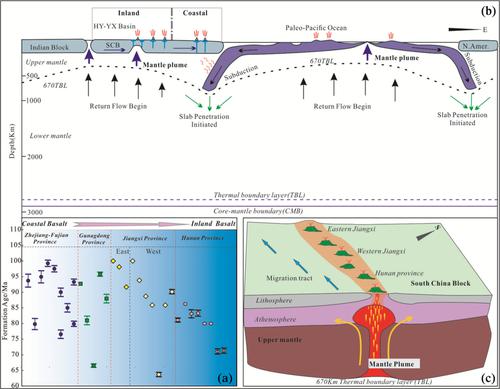当前位置:
X-MOL 学术
›
Geolog. J.
›
论文详情
Our official English website, www.x-mol.net, welcomes your
feedback! (Note: you will need to create a separate account there.)
Geochemical and Sr–Nd–Pb isotopic characteristics of basalt from eastern Hunan Province: New insight for the Late Cretaceous tectonic dynamic mechanism in South China
Geological Journal ( IF 1.4 ) Pub Date : 2020-08-03 , DOI: 10.1002/gj.3914 Jin‐hua Qin 1 , Deng‐hong Wang 1 , Yu‐chuan Chen 2
Geological Journal ( IF 1.4 ) Pub Date : 2020-08-03 , DOI: 10.1002/gj.3914 Jin‐hua Qin 1 , Deng‐hong Wang 1 , Yu‐chuan Chen 2
Affiliation

|
During the Late Cretaceous period, massive magmatism occurred in South China. Eastern Hunan Province is situated in the inland part of South China. Comparing with the coastal area, the inland of South China is characterized by the absence of intermediate‐acid intrusive rocks, but the occurrence of multiple mafic rocks. To date, the emplacement and triggering mechanism of magmatism of inland South China is still very puzzling. In this article, we address this question by concentrating on the basalt exposed in eastern Hunan Province. Geochronologically, three stages of zircon grains, which include xenocrysts and authigenic crystals (rare), are recognized, and the last stage of zircon grains with a concordant age of 79.93 ± 0.47 Ma (MSWD = 1.9) represents the actual crystallization age of basaltic magma. Geochemically, the basalt in eastern Hunan Province has low TiO2 and K2O contents (1.11–2.63 and 0.28–2.88 wt%) but high alkali contents (3.75–6.58 wt%) and K2O/Na2O ratios (0.05–0.56). The basalts from eastern Hunan Province are enriched in large‐ion lithophile elements and light rare earth elements and obviously depleted in heavy rare earth elements with weak negative Eu anomalies (Eu/Eu* = 0.87–1.26); they lack significant Ti, Nb, Ta, etc., depletions. These features are much different from those of coastal basalt with strong arc‐related signatures. The incompatible element ratios and Sr–Nd–Pb isotope compositions commonly imply significant EMII‐type OIB‐like source region and within‐plate basalt characteristics. The basalt may have suffered from earlier partial melting of garnet‐spinel peridotite and later rapid fractional crystallization of mafic minerals (olivine and pyroxene). Significant geochemical and petrological discrepancies between inland basalt and coastal basalt suggest a subduction‐absent within‐plate setting for inland basalt but a strong subduction‐related signature for coastal basalt. The magmatic age of mafic rocks from inland South China hold a significant tendency to become younger to the west. The spatial and temporal distribution and variation of components of basalt in South China indicated a mantle plume model which is derived from the 670 km thermal boundary layer (670 TBL) between the lower and upper mantle. The trigger mechanism of this model could be attributed to the westward steep rollback subduction of the Palaeo‐Pacific Plate in the Late Cretaceous.
中文翻译:

湘东玄武岩的地球化学特征和Sr-Nd-Pb同位素特征:对华南晚白垩世构造动力机制的新认识
在白垩纪晚期,华南发生了大型岩浆活动。湘东省地处华南内陆。与沿海地区相比,华南内陆的特征是缺乏中酸性侵入岩,但存在多块镁铁质岩体。迄今为止,华南内陆岩浆活动的形成和触发机制仍很令人困惑。在本文中,我们通过集中研究湘东地区暴露的玄武岩来解决这个问题。从时间上看,锆石晶粒的三个阶段,包括异种晶和自生晶体(稀有)被识别,而锆石晶粒的最后一个阶段的一致年龄为79.93±0.47 Ma(MSWD = 1.9)代表了玄武质岩浆的实际结晶年龄。地球化学2和K 2 O含量(1.11-2.63和0.28-2.88 wt%),但碱含量高(3.75-6.58 wt%)和K 2 O / Na 2O比率(0.05-0.56)。湘东地区的玄武岩富含大离子的嗜石元素和轻稀土元素,而贫铀负异常较弱的重稀土元素明显贫化(Eu / Eu * = 0.87-1.26)。它们缺乏大量的Ti,Nb,Ta等耗尽。这些特征与具有强烈弧相关特征的沿海玄武岩有很大不同。不兼容的元素比率和Sr–Nd–Pb同位素组成通常暗示显着的EMII型OIB样源区和板内玄武岩特征。玄武岩可能会遭受石榴石-尖晶石橄榄岩的早期部分熔融以及后来的镁铁质矿物(橄榄石和辉石)快速分级结晶。内陆玄武岩与沿海玄武岩之间存在明显的地球化学和岩石学差异,这表明内陆玄武岩板内不存在俯冲作用,而沿海玄武岩则具有强烈的俯冲作用。来自华南内陆的镁铁质岩浆的岩浆时代具有明显的向西部变年轻的趋势。华南地区玄武岩成分的时空分布和变化指示了地幔柱模型,该模型是由上,下地幔之间的670 km热边界层(670 TBL)得出的。该模型的触发机制可以归因于晚白垩世古太平洋板块向西陡峭的俯冲俯冲。来自华南内陆的镁铁质岩石的岩浆时代具有向西变年轻的明显趋势。华南地区玄武岩成分的时空分布和变化指示了地幔柱模型,该模型是由上,下地幔之间的670 km热边界层(670 TBL)得出的。该模型的触发机制可以归因于晚白垩世古太平洋板块向西陡峭的俯冲俯冲。来自华南内陆的镁铁质岩石的岩浆时代具有向西变年轻的明显趋势。华南地区玄武岩成分的时空分布和变化指示了地幔柱模型,该模型是由上,下地幔之间的670 km热边界层(670 TBL)得出的。该模型的触发机制可以归因于晚白垩世古太平洋板块向西陡峭的俯冲俯冲。
更新日期:2020-08-03
中文翻译:

湘东玄武岩的地球化学特征和Sr-Nd-Pb同位素特征:对华南晚白垩世构造动力机制的新认识
在白垩纪晚期,华南发生了大型岩浆活动。湘东省地处华南内陆。与沿海地区相比,华南内陆的特征是缺乏中酸性侵入岩,但存在多块镁铁质岩体。迄今为止,华南内陆岩浆活动的形成和触发机制仍很令人困惑。在本文中,我们通过集中研究湘东地区暴露的玄武岩来解决这个问题。从时间上看,锆石晶粒的三个阶段,包括异种晶和自生晶体(稀有)被识别,而锆石晶粒的最后一个阶段的一致年龄为79.93±0.47 Ma(MSWD = 1.9)代表了玄武质岩浆的实际结晶年龄。地球化学2和K 2 O含量(1.11-2.63和0.28-2.88 wt%),但碱含量高(3.75-6.58 wt%)和K 2 O / Na 2O比率(0.05-0.56)。湘东地区的玄武岩富含大离子的嗜石元素和轻稀土元素,而贫铀负异常较弱的重稀土元素明显贫化(Eu / Eu * = 0.87-1.26)。它们缺乏大量的Ti,Nb,Ta等耗尽。这些特征与具有强烈弧相关特征的沿海玄武岩有很大不同。不兼容的元素比率和Sr–Nd–Pb同位素组成通常暗示显着的EMII型OIB样源区和板内玄武岩特征。玄武岩可能会遭受石榴石-尖晶石橄榄岩的早期部分熔融以及后来的镁铁质矿物(橄榄石和辉石)快速分级结晶。内陆玄武岩与沿海玄武岩之间存在明显的地球化学和岩石学差异,这表明内陆玄武岩板内不存在俯冲作用,而沿海玄武岩则具有强烈的俯冲作用。来自华南内陆的镁铁质岩浆的岩浆时代具有明显的向西部变年轻的趋势。华南地区玄武岩成分的时空分布和变化指示了地幔柱模型,该模型是由上,下地幔之间的670 km热边界层(670 TBL)得出的。该模型的触发机制可以归因于晚白垩世古太平洋板块向西陡峭的俯冲俯冲。来自华南内陆的镁铁质岩石的岩浆时代具有向西变年轻的明显趋势。华南地区玄武岩成分的时空分布和变化指示了地幔柱模型,该模型是由上,下地幔之间的670 km热边界层(670 TBL)得出的。该模型的触发机制可以归因于晚白垩世古太平洋板块向西陡峭的俯冲俯冲。来自华南内陆的镁铁质岩石的岩浆时代具有向西变年轻的明显趋势。华南地区玄武岩成分的时空分布和变化指示了地幔柱模型,该模型是由上,下地幔之间的670 km热边界层(670 TBL)得出的。该模型的触发机制可以归因于晚白垩世古太平洋板块向西陡峭的俯冲俯冲。











































 京公网安备 11010802027423号
京公网安备 11010802027423号